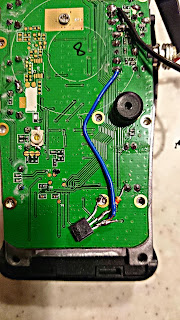Our project has a new payload - redesigned APRS tracker and a VHF/UHF voice repeater.
APRS tracker is made of Arduino Nano, and G-Space Bluetooth GPS receiver - with RS232 data bus taken from the mainboard. Arduino Nano is powered using internal GPS receiver battery (3.7 V) upconverted to the 5V. We are using awesome QAPRS library (https://bitbucket.org/Qyon/arduinoqaprs/downloads) to generate the modulated audio signal and pass it to the VHF transmitter.
 |
| APRS tracker internals |
 | |
| APRS tracker mounted to the back of a VHF radio |
Another part of the payload if a VHF/UHF radio repeater. We started to build our own but a more effective solution (resulting in lighter payload) was to use a repeater build into a Wouxun KG-UV8D dual-band, handheld radio.
 | ||
| Don't worry - this line only looks like it is loosely attached to the radio :) |
Due to a weak wind we were able to lift the payload only 73 meters above the ground. APRS direct radio path was 59 kilometers. Wouxun UV8D was set up to work as a two-way dual band repeater on 145,500/438,500 MHz frequency pair. Kite operators were calling on a 438,500 MHz frequency. Launch site was about 80 km from Warsaw (Poland) and unfortunately our friends in Warsaw that were monitoring 145,500 MHz frequency weren't able to get a usable signal.
All transmitter were using 5W of power each. Unfortunately this time we were forced to use lower quality antennas (all-use uhf/vhf vendor supplied) which resulted in weaker coverage. We confirmed that all parts of a set-up: kite, line winder, APRS tracker and voice repeater work fine and their weight is low enough to be lift up during moderate wind conditions.
Next goal: to lift payload 250 meters above ground and establish reliable voice connection. We also plan to achieve direct path APRS data transmission of 150 km.






